Do you have a question about the Iiyama ProLite T2454MSC and is the answer not in the manual?
Essential warnings to prevent harm, fire, or electric shock during operation and handling.
Important notices regarding installation location, ventilation, and proper handling to avoid damage or hazards.
Advice for comfortable viewing and reducing eye strain during prolonged monitor use.
Explains normal LCD symptoms and potential issues like uneven brightness or afterimages.
Instructions for contacting service if original packaging is discarded for returns.
Safety precautions and methods for cleaning the monitor cabinet and LCD screen safely.
Lists key specifications and capabilities of the LCD monitor, like resolution and connectivity.
Guide to verify all included accessories are present upon unpacking.
Instructions and warnings for securely installing the monitor, including wall mounting considerations.
Specific guidance for wall mounting, including screw length to avoid electrical contact.
Identifies and describes buttons, indicators, and connection ports on the front and back of the monitor.
Details the function of each input/output connector, including USB, HDMI, VGA, and audio.
Step-by-step guide for connecting the monitor to the computer and audio equipment.
Illustrates a typical connection setup and provides important notes on cables and power.
Configuration for signal timing and touch input compatibility across different OS.
Explanation of the palm rejection feature for touch screen usability.
Detailed steps for configuring touch input when using multiple displays.
Instructions on how to adjust the monitor's height and tilt angle for optimal viewing.
Guide to navigate and use the On-Screen Display (OSD) menu for picture adjustments.
Information on how settings are saved and important notes regarding OSD timeout and power.
Details on adjusting Brightness, Contrast, Eco modes, and i-Style Color settings.
Explanation of the Advanced Contrast feature and its impact on other settings.
Adjustments for Pixel Clock and Phase to correct flickering and text clarity.
Instructions for adjusting Horizontal/Vertical Position and Aspect Ratio for proper display fit.
Adjustments for Gamma settings and Color Temperature (Cool, Normal, Warm, sRGB).
Configuration for OSD display position, duration, and language selection.
Settings for Auto Power Off function and Touch Wake Up behavior.
Options for resetting settings, selecting input sources (VGA, HDMI), and audio input.
Control for opening logo, power LED, overdrive feature, and displaying input signal information.
Direct access to Volume control and automatic adjustment of image settings.
Features for reducing blue light and locking/unlocking OSD or power buttons.
Introduction to screen adjustments, optimal resolution, and performing the Auto Adjust function.
Detailed steps for manual adjustment of H/V-POSITION, H-SIZE, and FINE using patterns.
Adjusting FINE for wavy lines/flicker and final Brightness/Color adjustments.
Explains the monitor's power saving feature and how it enters/exits Power Management Mode.
Details power consumption in different modes and advice on turning off the monitor.
Solutions for problems like no picture, incorrect synchronization, or screen position.
Troubleshooting for brightness, shaking, sound, and noise problems.
Solutions for touch screen response issues and audio noise problems.
Guidance on environmentally friendly disposal and recycling of the monitor.
Detailed technical specifications of the monitor, including dimensions, power, and approvals.
Physical dimensions of the monitor in millimeters and inches.
Table of compliant video modes, frequencies, and dot clocks for optimal performance.
Essential warnings to prevent harm, fire, or electric shock during operation and handling.
Important notices regarding installation location, ventilation, and proper handling to avoid damage or hazards.
Advice for comfortable viewing and reducing eye strain during prolonged monitor use.
Explains normal LCD symptoms and potential issues like uneven brightness or afterimages.
Instructions for contacting service if original packaging is discarded for returns.
Safety precautions and methods for cleaning the monitor cabinet and LCD screen safely.
Lists key specifications and capabilities of the LCD monitor, like resolution and connectivity.
Guide to verify all included accessories are present upon unpacking.
Instructions and warnings for securely installing the monitor, including wall mounting considerations.
Specific guidance for wall mounting, including screw length to avoid electrical contact.
Identifies and describes buttons, indicators, and connection ports on the front and back of the monitor.
Details the function of each input/output connector, including USB, HDMI, VGA, and audio.
Step-by-step guide for connecting the monitor to the computer and audio equipment.
Illustrates a typical connection setup and provides important notes on cables and power.
Configuration for signal timing and touch input compatibility across different OS.
Explanation of the palm rejection feature for touch screen usability.
Detailed steps for configuring touch input when using multiple displays.
Instructions on how to adjust the monitor's height and tilt angle for optimal viewing.
Guide to navigate and use the On-Screen Display (OSD) menu for picture adjustments.
Information on how settings are saved and important notes regarding OSD timeout and power.
Details on adjusting Brightness, Contrast, Eco modes, and i-Style Color settings.
Explanation of the Advanced Contrast feature and its impact on other settings.
Adjustments for Pixel Clock and Phase to correct flickering and text clarity.
Instructions for adjusting Horizontal/Vertical Position and Aspect Ratio for proper display fit.
Adjustments for Gamma settings and Color Temperature (Cool, Normal, Warm, sRGB).
Configuration for OSD display position, duration, and language selection.
Settings for Auto Power Off function and Touch Wake Up behavior.
Options for resetting settings, selecting input sources (VGA, HDMI), and audio input.
Control for opening logo, power LED, overdrive feature, and displaying input signal information.
Direct access to Volume control and automatic adjustment of image settings.
Features for reducing blue light and locking/unlocking OSD or power buttons.
Introduction to screen adjustments, optimal resolution, and performing the Auto Adjust function.
Detailed steps for manual adjustment of H/V-POSITION, H-SIZE, and FINE using patterns.
Adjusting FINE for wavy lines/flicker and final Brightness/Color adjustments.
Explains the monitor's power saving feature and how it enters/exits Power Management Mode.
Details power consumption in different modes and advice on turning off the monitor.
Solutions for problems like no picture, incorrect synchronization, or screen position.
Troubleshooting for brightness, shaking, sound, and noise problems.
Solutions for touch screen response issues and audio noise problems.
Guidance on environmentally friendly disposal and recycling of the monitor.
Detailed technical specifications of the monitor, including dimensions, power, and approvals.
Physical dimensions of the monitor in millimeters and inches.
Table of compliant video modes, frequencies, and dot clocks for optimal performance.
| Panel Type | IPS |
|---|---|
| Resolution | 1920 x 1080 (Full HD) |
| Brightness | 250 cd/m² |
| Contrast Ratio | 1000:1 |
| Response Time | 5 ms |
| Refresh Rate | 60 Hz |
| Touchscreen | Yes |
| Touch Technology | Projected Capacitive (PCAP) |
| Viewing Angle | 178°/178° |
| Aspect Ratio | 16:9 |
| Connectivity | VGA, HDMI, DisplayPort |
| Speakers | Yes |
| VESA Mount | Yes (100 x 100 mm) |
| USB Hub | Yes (4-port USB 3.0) |

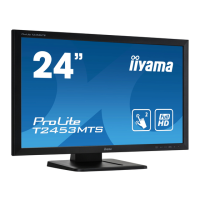
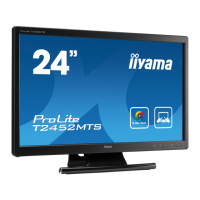



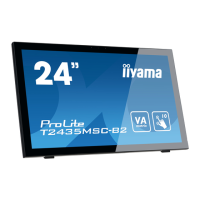
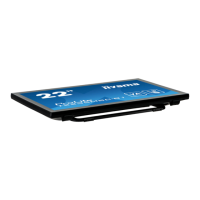
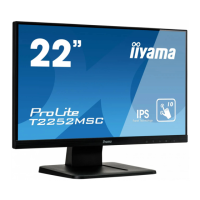


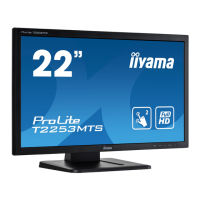
